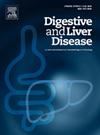Effect of Protease-Activated Receptor 2 inhibition by 1-Piperidinepropionic acid in lipid accumulation, inflammation and hepatocellular carcinoma development
IF 4
3区 医学
Q1 GASTROENTEROLOGY & HEPATOLOGY
引用次数: 0
Abstract
Introduction
Hepatocellular carcinoma (HCC) and Metabolic-Associated Steatohepatitis (MASH) are major challenges in modern hepatology. 1-Piperidinepropionic Acid (1-PPA) is a novel inhibitor of Protease-Activated Receptor 2 (PAR2), which is involved in inflammation, lipid accumulation and tumour development. This study aims to evaluate the effect of 1-PPA on liver steatosis, inflammation and HCC development.
Materials
C57BL/6J mice transgenic overexpressing SerpinB3 (C57/TG), fed on a CDAA diet and injected with diethylnitrosamine (DEN) were divided into two groups (n=8 each) and treated with 1-PPA or placebo. HCC development was confirmed by liver histology. Microsomal triglyceride transfer protein (MTP) activity was quantified in liver tissue using a specific assay. qPCR of macrophage M2-polarization markers was carried out. Human liver organoids were cultured with Oleic Acid and SB3, and treated with 1-PPA and lomitapide, an inhibitor of VLDL export. Lipid and ROS accumulation was quantified using BodiPY and MitoSOX respectively.
Results
C57/TG mice treated with 1-PPA developed a lower mean number of nodules (1.5 vs 5, p < 0.05), a reduced mean tumoral mass (0.04 vs 0.1 g, p < 0.01) and a blunted expression of M2-polarization macrophage markers. MTP activity was increased in the liver of mice treated with 1-PPA. Human liver organoids showed a significant increase in lipid and ROS accumulation after Oleic Acid administration. Treatment with 1-PPA significantly lower lipid and ROS accumulation, however contemporary treatment with lomitapide reverted this effect, suggesting a role in VLDL export.
Conclusion
1-PPA treatment reduced HCC development by reducing lipid accumulation and M2-macrophage polarization in a mouse model of NASH-induced liver carcinogenesis. 1-PPA treatment reduced lipid accumulation by stimulating VLDL formation and secretion both in a mouse model of MASH-induced liver carcinogenesis and in human liver organoids.
求助全文
约1分钟内获得全文
求助全文
来源期刊

Digestive and Liver Disease
医学-胃肠肝病学
CiteScore
6.10
自引率
2.20%
发文量
632
审稿时长
19 days
期刊介绍:
Digestive and Liver Disease is an international journal of Gastroenterology and Hepatology. It is the official journal of Italian Association for the Study of the Liver (AISF); Italian Association for the Study of the Pancreas (AISP); Italian Association for Digestive Endoscopy (SIED); Italian Association for Hospital Gastroenterologists and Digestive Endoscopists (AIGO); Italian Society of Gastroenterology (SIGE); Italian Society of Pediatric Gastroenterology and Hepatology (SIGENP) and Italian Group for the Study of Inflammatory Bowel Disease (IG-IBD).
Digestive and Liver Disease publishes papers on basic and clinical research in the field of gastroenterology and hepatology.
Contributions consist of:
Original Papers
Correspondence to the Editor
Editorials, Reviews and Special Articles
Progress Reports
Image of the Month
Congress Proceedings
Symposia and Mini-symposia.
 求助内容:
求助内容: 应助结果提醒方式:
应助结果提醒方式:


